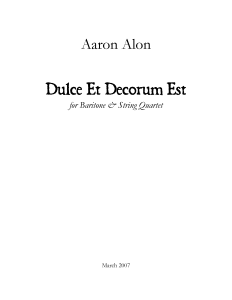With so many excellent compositions submitted to contests, calls, and colleges, adjudicators have to look for ways to thin the herd. If your score doesn’t look good, chances are that it will be cut before it’s given a really earnest listening. Attention to detail in your presentation can also help rehearsals run more smoothly and show that you are invested in your work, encouraging others to do the same. For all of these reasons, the look of your scores can be as important as the sound of your scores. This guide will help you prepare professional scores for concert music.
The Front Cover | Front Matter | First Page of Your Score | Subsequent Pages | Back Cover | General Guidelines | Part Preparation Guidelines
The Front Cover
The front cover of your score is the first thing people see. I recommend that you keep it simple, clean, and professional in appearance and be sure to include all of the following:
- Your full name
- The title of your piece
- The instrumentation of your piece
- The month and year in which your piece was composed
Here’s a sample from one of my pieces:
Front Matter
After your cover page, you want to include all of the information that people could want or need before actually getting to the score. I recommend you include:
- The duration: You’ll often see “ca.” before the time. This stands for circa (a term from Latin meaning “approximately”). The time is usually listed in minutes (e.g., “ca. 3½ minutes”) or minutes and seconds (e.g., “ca. 3 minutes 40 seconds,” “ca. 3:45,” or “ca. 3’45”).
- Instrumentation: List the complete instrumentation for your work. I recommend favoring modern terminology (like “cello”) over over terminology for instruments (like “violoncello”). If there are different versions of the instrument, such as with transposing instruments, include which one this is written for (like “B-flat trumpet”).
- Performance Notes: Explain any atypical notation (including notation for extended techniques) and give any other notes relevant to the performance of the work. Also include:
- Rules for accidentals: For instance, “Accidentals only apply to the octave where written. All accidentals carry through to the end of the measure. The use of courtesy accidentals does not imply a relaxation of this rule elsewhere.” Even with this note, it’s still best to liberally include courtesy accidentals.
- Rules for transposition in C scores: Which instruments are displayed 1-2 octaves above/below where they sound?
- In transposed scores, this is not necessary, unless you do anything that’s nonstandard. The exception is when notation has changed historically, such as for French Horn, where it’s helpful to say how the transposition is to be read. It’s often good to state this for guitar too.
- If you have percussion in your score, include a legend indicating what various lines/spaces on non-pitched staves are used to mean. (Be consistent in your score and use standard practices where possible, such as for drum set.) Here’s an example of what this looks like:

- Program Notes: Give notes about the piece that tell a little background. Were you inspired by something? Is there a program or background story? Is there a musical narrative? These notes should be the sorts of things that would go into the program at a performance of your work. They help give listeners and musicians an “in,” allowing them access to your thoughts about the piece.
- Copyright Notice. There are different formats, but it should include
- © symbol
- The year
- Your performance rights organization, if you have one (in the US, ASCAP, BMI, or SESAC)
- The indication “All Rights Reserved.”
- EXAMPLE: ©2009 Aaron Alon (ASCAP). All Rights Reserved.
- The Publisher for your piece, if there is one.
- Your Website. If you don’t have a website where people can learn more and contact you, provide you contact information.
- Commission or Grant Information: If your piece was commissioned or supported by a grant, list that here.
- Text: If it’s a vocal piece, include the text, poet, and a note explaining if you have text permissions (if so, cite according to the agreement contract) or if you don’t need them because the work is in public domain.
![]() Open this pdf to see the extensive front matter from my piece SOUL FLOW (with text by Tacey A. Rosolowski).
Open this pdf to see the extensive front matter from my piece SOUL FLOW (with text by Tacey A. Rosolowski).
First Page of Your Score
Only now do you come to your actual sheet music. Be sure to include the following.
- Score/Part Indication: In the upper left-hand corner, write “Score in C” or “Transposed Score.” You can forgo this or just write “Score” if you are writing for just a handful of non-transposing instruments. If this is one of the parts, you should indicate the part here, such as “B-flat Clarinet.”
- Correct Order: Be sure that the instruments are listed in score order. In chamber music with piano, note that the piano is usually at the bottom.
- Title: In the top center of the page, include the title of your piece.
- Writers: In the upper right-hand corner, write your name. (For collaborations with a lyricist in a musical or song, write “Music by YOUR NAME” and then, underneath, write “Lyrics by HIS/HER NAME.”)
- Copyright: Centered, on the bottom, include another copyright notification.
- First System Instrumentation: In the first system, list the full instrument names and include all instruments. In subsequent systems, use abbreviations for the instrument names (if you only have 1-2 instruments, you can omit instrument names entirely). You can leave out the staves for instruments that aren’t playing in any given system, if you’d like (this is called staff optimization).
- The first system is usually slightly indented.
- Tempo and Descriptor: Be sure to include a starting tempo and a descriptor. For the tempo, be precise; use metronome markings and show what note value gets the beat. Also include a descriptor! For instance, “playful,” “whimsical,” “lugubrious,” “dark and sinister,” etc. (Try to use either adjectives or adverbs, but preferably not both, as you add in descriptors later in the piece.)
- E.g., With Excitement
 =120
=120
- E.g., With Excitement
Here’s a sample first page:

Subsequent Pages
You need less information on your future pages, but here are some things you should be sure to include:
- Page Numbers: Number subsequent pages in the upper outer corners of the page.
- Measure Numbers: Give the measure number at the start of each system.
- Rehearsal Letters: Give rehearsal letters, especially for larger works.
- Page Turns: If this is a musician’s part (as opposed to the full score), make sure all page turns are possible, even if it means having a good part of the page empty. Some scores include the note, “This section left blank for page turns.”
- Good Notational Practices: Though this is a separate topic, don’t forget good notational practices, including dynamics, tempo changes, descriptions, slurring, etc.
- Running Header: Include the title of the piece at the top center of each page. If this is a part, include the instrument playing too. Sometimes this is placed as a footer of the page instead.
- E.g., “EVEREST — Flute”
Here’s a sample page from an orchestral piece:

Back Cover
Some composers choose to have a back cover for their works, often where they list other works. Some have a blank space to put current address stickers. Simpler back covers are often used too, as our backs without text (including black vinyl in coil-bound scores). I personally favor a simple back that includes a revision date (so you know if you’re looking at a current draft of the score) and your website. Mine look like this:

General Guidelines
- All scores should be bound! The best binding for thin scores is saddle-stitch or coil binding. Comb binding is a poor choice. You can also use tape binding as a back-up option. Scores should be able to lie flat. Thick scores can be book or coil bound.
- Double-Sided: With the exception of the cover/back, print your music double-sided. If page turns are a problem, you can include blank pages with the note “This page left blank for page turns.”
- Thicker Covers: Covers and backs should be thicker, like cardstock (or vinyl for the back).
- Professional Printing: I recommend a professional printing service. There are many local print shops. For letter-size scores, I tend to favor uploading my scores to lulu.com and ordering prints from there. The end result is beautiful!
- No Loose Pages: Never submit a score consisting of loose pages. Even a paper/binder clip, while better, is insufficient. The exception to this is when you have a part where the player will need to spread out the pages. Then, create a professional looking cover and put the pages inside. I recommend a small binder clip to keep the pages from falling out.
Part Preparation Guidelines
Most of the guidelines for parts are the same as for scores. Here are some extra recommendations:
- Show Only the Player’s Part: Show only the part that the player is playing.
- Exception 1: Include cues in the same staff, where helpful, with notes and rests shrunk to about 70%, with the instrument labeled, especially after long periods of rest.
- Exception 2: Sometimes, it may be helpful to include another staff with cue parts beneath the staff. Shrink this entire staff to about 70-75% and clearly label what instrument(s) is/are playing.
- Exception 3: In very complex scores (and often in pianists’ parts), players will sometimes read off of the full score. Make sure that transposing instruments’ parts are transposed if your original score is a C score. It’s usually helpful to shrink the other parts (to about 70-75%), so that the player’s part stands out and you can fit more to a page.
- Transposed Cues: Cues should be transposed to match the part in which they occur. Also, use the clef(s) the instrumentalist is accustomed to reading.
- Check Your Transposition: Make sure to transpose their parts correctly. Note that if the player plays more than one instrument, different transpositions may be required.
- Mark Changes of Instrument: If the player changes instruments, mallets, etc., write “to …” to indicate the upcoming change (e.g.: “to bass clarinet” or “to brushes”) and then indicate when that change occurs (e.g. “bass clarinet” or “with brushes”). Sometimes, it’s helpful to box the latter of these (when it occurs).
- Check Your Page Turns: Make sure page turns are all possible. If your score is up to 3 pages (max. 4, with 2 stands), the player will likely prefer single-sided parts so that (s)he can spread out the pages. Otherwise, use bound, double-sided parts.
- If necessary, leave portions of the page (or even the entire page) blank in order to facilitate better (and quieter) page turns. You can type, “This section left blank for page turn.”
- Part Name: Put the part name in the upper left-hand corner of the first page. Subsequent pages should include the title and the part name (e.g.: “SOUL FLOW – CLARINET”).
- Multi-Measure Rests: Multi-measure rests may be used. For sections of long multi-measure rests, it can be helpful to break them up to show sections or phrases. It’s helpful to show the range of measure numbers underneath the multimeasure rests (e.g.: “15-22”)
- Rehearsal Letters: Rehearsal letters are recommended, particularly in longer pieces, to facilitate the rehearsal process. Always show these in the parts, even if it means breaking a multi-measure rest.
- Harp Pedaling: For harp parts, show the pedaling in the parts. This may be omitted in the score if desired. This includes an initial harp pedal diagram and changes where they occur. Occasionally harp pedal diagrams can be used at the starts of sections, so that the harpist can set his/her pedaling for starting somewhere in the middle of the piece in rehearsal.
- Guitar Chord Names: For guitar parts, chord names (and, optionally, tablature) can be helpful in the parts. These should be omitted in the score, except in popular music.
YOUR RECOMMENDATIONS
What score and part preparation guidelines do you find helpful? Comment on this post to share your best tips!
©2016 Aaron Alon. All Rights Reserved.











Very useful. However, I’d also mention that one should consider assigning the IMSN as an outside-footer and the website as an inside-footer, at least in the first page of the score.
Also, in the case of songs, perhaps the text should come in the end and not in the beginning?…
Add on: and usually on the first page of the score, on the top-left corner the logo of a crossed-printer followed by the text in small font “Unauthorized copying of music is prohibited by law.
Violations can lead to civil and criminal prosecution.
All rights reserved. No part of this publication may be reproduced, stored in a retrieval system, or transmitted in any form or by any means, electronic, mechanical, photocopying, recording or otherwise, without the pior written permission of the music publisher”.
Thanks for the recommendations, Tiago, and I’m glad you found this blog helpful! As for the copyright notification, my understanding is that putting the copyright info with “All Rights Reserved” should cover it, as this refers to protecting the six rights that are bundled into copyright, which includes reproduction, etc. The rest of the language is likely legally redundant, but may be helpful for the sake of absolute clarity. Thanks again for sharing your thoughts!
Great job Aaron! Often in chamber music pianists ask for a score as you’ve indicated in Exception #3 rather than the piano part alone. I will go ahead and provide both if I don’t know the pianist.
Well said! Thanks, Richard. I’ve updated the blog to mention that this exception is common in piano parts. Thanks for the feedback!